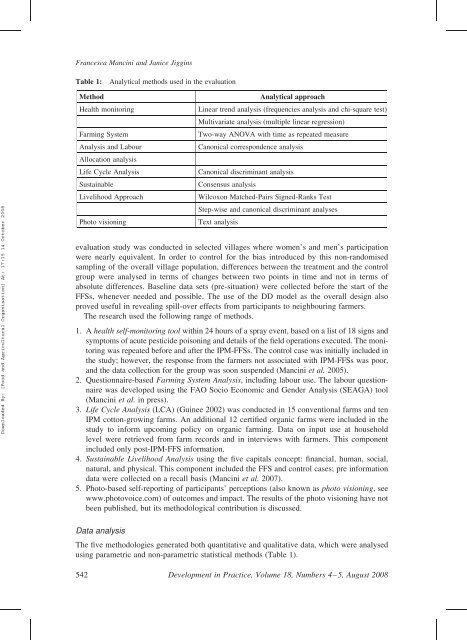<strong>Appraisal</strong> <strong>of</strong> <strong>methods</strong> <strong>to</strong> <strong>evaluate</strong> <strong>farmer</strong> <strong>field</strong> <strong>schools</strong>Downloaded By: [Food and Agricultural Organisation] At: 17:15 14 Oc<strong>to</strong>ber 2008acts and processes <strong>of</strong> participation can reinforce injustice and any imbalance in existing powerrelations, if the complex manifestation and dynamics <strong>of</strong> power are not unders<strong>to</strong>od. He claimsthat the currently available examples <strong>of</strong> applied participa<strong>to</strong>ry approaches can only reveal butnever challenge power inequalities, and that therefore a ‘misunderstanding <strong>of</strong> power underpinsthe participation discourse’.The debate about how an evaluation should be assessed, what exactly should be assessed, andwho should carry out the assessment is far from being solved, and probably there will always bedivergent opinions; but it is clear that a broad array <strong>of</strong> evaluation approaches and methodologicalinnovation are required <strong>to</strong> follow the evolving concept <strong>of</strong> evaluating development. In thisarticle, we report on the case <strong>of</strong> an evaluation <strong>of</strong> the ecological, agronomic, social, andhuman outcomes associated with IPM-FFSs in India, using a range <strong>of</strong> methodologies from conventional<strong>to</strong> participa<strong>to</strong>ry. The aspects <strong>of</strong> sustainability addressed by the research were: (1) theoccupational health <strong>of</strong> male and female farm workers engaged in the handling and application<strong>of</strong> pesticides; (2) the changes in <strong>farmer</strong>s’ agronomic practices, particularly in input use, determinedby the adoption <strong>of</strong> IPM; (3) the reallocation <strong>of</strong> labour associated with the introduction <strong>of</strong>IPM tasks, and its gender implications; (4) the ecological impact <strong>of</strong> the emissions released in<strong>to</strong>the environment by conventional, integrated, and organic cot<strong>to</strong>n cultivation; and (5) the overalleffects <strong>of</strong> the IPM-FFSs on livelihoods. Secondary aims <strong>of</strong> the research were <strong>to</strong> assess the role<strong>of</strong> participa<strong>to</strong>ry approaches <strong>to</strong> evaluation in enhancing the relevance <strong>of</strong> the evaluation, and <strong>to</strong>test innovative applications <strong>of</strong> the <strong>methods</strong> used.The research framework, including <strong>methods</strong> for data collection and analysis, is briefly presented.The findings, published elsewhere, are summarised. We proceed <strong>to</strong> define the degree<strong>to</strong> which each method was participa<strong>to</strong>ry and at what stages <strong>farmer</strong>s were involved. Finally, acritical review <strong>of</strong> the limitations and strengths <strong>of</strong> the <strong>methods</strong> used is reported.Study designResearch <strong>methods</strong>Data were collected between 2002 and 2004 from 20 villages in the cot<strong>to</strong>n-growing states <strong>of</strong>Andhra Pradesh, Maharashtra, and Karnataka, <strong>to</strong> assess the short-term effects <strong>of</strong> IPM-FFSsup <strong>to</strong> two years after the intervention. The overall design followed the Double Difference(DD) model, identifying the FFSs as the treatment variable and studying the pre- and posttreatmentsituation for <strong>farmer</strong>s who attended IPM-FFSs and <strong>farmer</strong>s who did not (control).The control <strong>farmer</strong>s were living either in the IPM-FFS villages (first control) or, in somecases, in villages from the same agro-ecological zone but where IPM-FFSs had never beenconducted (second control). The matching criteria used <strong>to</strong> select control <strong>farmer</strong>s were landholdingand cropping patterns. The importance <strong>of</strong> using the DD model in assessing theimpact <strong>of</strong> FFSs rests on the non-random (that is, purposive) selection <strong>of</strong> FFS participants. Inmany cases, FFS programmes used explicit criteria <strong>to</strong> select participant <strong>farmer</strong>s, such as croppingpattern or high pesticide use. Involuntary bias related <strong>to</strong> villagers’ different socioeconomicstatus can lead, and in some reported cases has led, <strong>to</strong> a higher participation by themore progressive, educated, and wealthy <strong>farmer</strong>s <strong>of</strong> a village. In the case treated here, itwould be incorrect <strong>to</strong> attribute observed differences between FFS <strong>farmer</strong>s and control<strong>farmer</strong>s entirely <strong>to</strong> the FFS intervention, since they could be linked also <strong>to</strong> the characteristics<strong>of</strong> the selected groups. In this case, for instance, the involvement <strong>of</strong> women was actively promoted,with the result that, in 2004, in the villages where gender-sensitisation modules wereimplemented, the participation <strong>of</strong> women increased <strong>to</strong> 50 per cent, and across the projectareas reached an average <strong>of</strong> 20 per cent. In order <strong>to</strong> generate gender-sensitive findings, theDevelopment in Practice, Volume 18, Numbers 4–5, August 2008 541
Francesca Mancini and Janice JigginsTable 1:Analytical <strong>methods</strong> used in the evaluationDownloaded By: [Food and Agricultural Organisation] At: 17:15 14 Oc<strong>to</strong>ber 2008MethodHealth moni<strong>to</strong>ringFarming SystemAnalysis and LabourAllocation analysisLife Cycle AnalysisSustainableLivelihood ApproachPho<strong>to</strong> visioningAnalytical approachLinear trend analysis (frequencies analysis and chi-square test)Multivariate analysis (multiple linear regression)Two-way ANOVA with time as repeated measureCanonical correspondence analysisCanonical discriminant analysisConsensus analysisWilcoxon Matched-Pairs Signed-Ranks TestStep-wise and canonical discriminant analysesText analysisevaluation study was conducted in selected villages where women’s and men’s participationwere nearly equivalent. In order <strong>to</strong> control for the bias introduced by this non-randomisedsampling <strong>of</strong> the overall village population, differences between the treatment and the controlgroup were analysed in terms <strong>of</strong> changes between two points in time and not in terms <strong>of</strong>absolute differences. Baseline data sets (pre-situation) were collected before the start <strong>of</strong> theFFSs, whenever needed and possible. The use <strong>of</strong> the DD model as the overall design alsoproved useful in revealing spill-over effects from participants <strong>to</strong> neighbouring <strong>farmer</strong>s.The research used the following range <strong>of</strong> <strong>methods</strong>.1. A health self-moni<strong>to</strong>ring <strong>to</strong>ol within 24 hours <strong>of</strong> a spray event, based on a list <strong>of</strong> 18 signs andsymp<strong>to</strong>ms <strong>of</strong> acute pesticide poisoning and details <strong>of</strong> the <strong>field</strong> operations executed. The moni<strong>to</strong>ringwas repeated before and after the IPM-FFSs. The control case was initially included inthe study; however, the response from the <strong>farmer</strong>s not associated with IPM-FFSs was poor,and the data collection for the group was soon suspended (Mancini et al. 2005).2. Questionnaire-based Farming System Analysis, including labour use. The labour questionnairewas developed using the FAO Socio Economic and Gender Analysis (SEAGA) <strong>to</strong>ol(Mancini et al. in press).3. Life Cycle Analysis (LCA) (Guinee 2002) was conducted in 15 conventional farms and tenIPM cot<strong>to</strong>n-growing farms. An additional 12 certified organic farms were included in thestudy <strong>to</strong> inform upcoming policy on organic farming. Data on input use at householdlevel were retrieved from farm records and in interviews with <strong>farmer</strong>s. This componentincluded only post-IPM-FFS information.4. Sustainable Livelihood Analysis using the five capitals concept: financial, human, social,natural, and physical. This component included the FFS and control cases; pre informationdata were collected on a recall basis (Mancini et al. 2007).5. Pho<strong>to</strong>-based self-reporting <strong>of</strong> participants’ perceptions (also known as pho<strong>to</strong> visioning, seewww.pho<strong>to</strong>voice.com) <strong>of</strong> outcomes and impact. The results <strong>of</strong> the pho<strong>to</strong> visioning have notbeen published, but its methodological contribution is discussed.Data analysisThe five methodologies generated both quantitative and qualitative data, which were analysedusing parametric and non-parametric statistical <strong>methods</strong> (Table 1).542 Development in Practice, Volume 18, Numbers 4–5, August 2008




![Section 4 [ PDF file, 252 KB] - The Field Alliance](https://img.yumpu.com/51387260/1/158x260/section-4-pdf-file-252-kb-the-field-alliance.jpg?quality=85)











